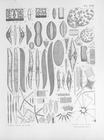Scheldt species taxon details
Asterionella formosa Hassall, 1850
148954 (urn:lsid:marinespecies.org:taxname:148954)
accepted
Species
recent only
Not documented
Kociolek, J.P.; Blanco, S.; Coste, M.; Ector, L.; Liu, Y.; Karthick, B.; Kulikovskiy, M.; Lundholm, N.; Ludwig, T.; Potapova, M.; Rimet, F.; Sabbe, K.; Sala, S.; Sar, E.; Taylor, J.; Van de Vijver, B.; Wetzel, C.E.; Williams, D.M.; Witkowski, A.; Witkowski, J. (2021). DiatomBase. Asterionella formosa Hassall, 1850. Accessed through: VLIZ Consortium Scheldt Species Register at: https://www.scheldemonitor.be/speciesregister/aphia.php?p=taxdetails&id=148954 on 2025-09-11
VLIZ Consortium. Scheldt Species Register. Asterionella formosa Hassall, 1850. Accessed at: https://www.scheldemonitor.nl/speciesregister/aphia.php?p=taxdetails&id=148954 on 2025-09-11
context source (RAS)
Australian Antarctic Data Centre. , available online at https://data.aad.gov.au/aadc/biodiversity/ [details]
context source (Schelde) Maris, T., O. Beauchard, S. Van Damme, E. Van den Bergh, S. Wijnhoven & P. Meire. (2013). Referentiematrices en Ecotoopoppervlaktes Annex bij de Evaluatiemethodiek Schelde-estuarium Studie naar “Ecotoopoppervlaktes en intactness index”. [Reference matrices and Ecotope areas Annex to the Evaluation methodology Scheldt estuary Study on “Ecotope areas and intactness index”. <em>Monitor Taskforce Publication Series, 2013-01. NIOZ: Yerseke.</em> 35 pp. (look up in IMIS) [details]
basis of record Muylaert, K.; Sabbe, K. (1999). Spring phytoplankton assemblages in and around the maximum turbidity zone of the estuaries of the Elbe (Germany), the Schelde (Belgium/The Netherlands) and the Gironde (France). <i>J. Mar. Syst. 22</i>: 133-149 (look up in IMIS) [details]
additional source Stoermer, E.F., R.G. Kreis, Jr. and N.A. Andersen. 1999. Checklist of diatoms from the Laurentian Great Lakes, II. Journal of Great Lakes Research 25(3): 515-566. [details]
additional source Hällfors, G. (2004). Checklist of Baltic Sea Phytoplankton Species (including some heterotrophic protistan groups). <em>Baltic Sea Environment Proceedings.</em> No. 95: 210 pp., available online at http://helcom.fi/Lists/Publications/BSEP95.pdf [details] Available for editors
additional source Fourtanier, E. & Kociolek, J. P. (compilers). (2011). Catalogue of Diatom Names. California Academy of Sciences, On-line Version. Updated 2011-09-19., available online at http://researcharchive.calacademy.org/research/diatoms/names/index.asp [details]
additional source Krayesky, D. M.; Meave, D. C.; Zamudio, E.; Norris, E.; Fredericq, S.; Tunnell, J. (2009). Diatoms (Bacillariophyta) of the Gulf of Mexico. <em>Gulf of Mexico origin, waters, and biota.</em> 1: 155-186. [details] Available for editors
additional source Hartley, B., Ross, R. & Williams, D.M. (1986). A check-list of the freshwater, brackish and marine diatoms of the British Isles and adjoining coastal waters. <em>Journal of the Marine Biological Association of the United Kingdom.</em> 66(3): 531-610. [details] Available for editors
additional source Integrated Taxonomic Information System (ITIS). , available online at http://www.itis.gov [details]
context source (Schelde) Maris, T., O. Beauchard, S. Van Damme, E. Van den Bergh, S. Wijnhoven & P. Meire. (2013). Referentiematrices en Ecotoopoppervlaktes Annex bij de Evaluatiemethodiek Schelde-estuarium Studie naar “Ecotoopoppervlaktes en intactness index”. [Reference matrices and Ecotope areas Annex to the Evaluation methodology Scheldt estuary Study on “Ecotope areas and intactness index”. <em>Monitor Taskforce Publication Series, 2013-01. NIOZ: Yerseke.</em> 35 pp. (look up in IMIS) [details]
basis of record Muylaert, K.; Sabbe, K. (1999). Spring phytoplankton assemblages in and around the maximum turbidity zone of the estuaries of the Elbe (Germany), the Schelde (Belgium/The Netherlands) and the Gironde (France). <i>J. Mar. Syst. 22</i>: 133-149 (look up in IMIS) [details]
additional source Stoermer, E.F., R.G. Kreis, Jr. and N.A. Andersen. 1999. Checklist of diatoms from the Laurentian Great Lakes, II. Journal of Great Lakes Research 25(3): 515-566. [details]
additional source Hällfors, G. (2004). Checklist of Baltic Sea Phytoplankton Species (including some heterotrophic protistan groups). <em>Baltic Sea Environment Proceedings.</em> No. 95: 210 pp., available online at http://helcom.fi/Lists/Publications/BSEP95.pdf [details] Available for editors
additional source Fourtanier, E. & Kociolek, J. P. (compilers). (2011). Catalogue of Diatom Names. California Academy of Sciences, On-line Version. Updated 2011-09-19., available online at http://researcharchive.calacademy.org/research/diatoms/names/index.asp [details]
additional source Krayesky, D. M.; Meave, D. C.; Zamudio, E.; Norris, E.; Fredericq, S.; Tunnell, J. (2009). Diatoms (Bacillariophyta) of the Gulf of Mexico. <em>Gulf of Mexico origin, waters, and biota.</em> 1: 155-186. [details] Available for editors
additional source Hartley, B., Ross, R. & Williams, D.M. (1986). A check-list of the freshwater, brackish and marine diatoms of the British Isles and adjoining coastal waters. <em>Journal of the Marine Biological Association of the United Kingdom.</em> 66(3): 531-610. [details] Available for editors
additional source Integrated Taxonomic Information System (ITIS). , available online at http://www.itis.gov [details]
 Present
Present  Inaccurate
Inaccurate  Introduced: alien
Introduced: alien  Containing type locality
Containing type locality
Diatom Flora of Britain and Ireland Note: Images and taxon treatment
PlanktonNet Image
To Barcode of Life
To Biodiversity Heritage Library (240 publications)
To European Nucleotide Archive, ENA (Asterionella formosa)
To GenBank (15507 nucleotides; 503 proteins)
To Global Biotic Interactions (GloBI)
To PESI
To ITIS
PlanktonNet Image
To Barcode of Life
To Biodiversity Heritage Library (240 publications)
To European Nucleotide Archive, ENA (Asterionella formosa)
To GenBank (15507 nucleotides; 503 proteins)
To Global Biotic Interactions (GloBI)
To PESI
To ITIS

